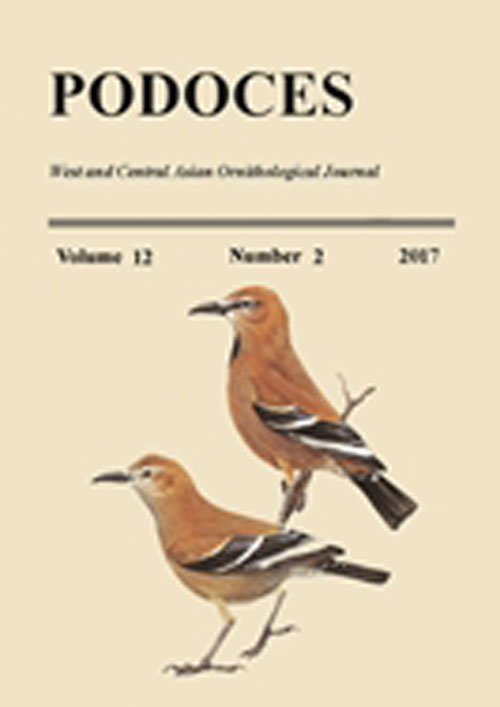فهرست مطالب

Podoces
Volume:12 Issue: 2, 2017
- تاریخ انتشار: 1396/08/20
- تعداد عناوین: 3
-
Pages 27-42This study aimed to document avifaunal diversity of the Zarivar Wildlife Refuge (ZWR), western Iran, to evaluate its potentiality to propose as a Ramsar site. Bird surveys were carried out during 2015–2016. In total, 222 species belonging to 50 families and 16 orders were identified, of which 95 species were new records for this habitat. Based on preferred habitat, 131 species were terrestrial birds (59%) and 91 species waterbirds (41%). Of 222 species, seven species are endangered and 30 species are protected species in Iran’s Department of the Environment. Twenty-one species are listed in the Appendix I and II of the Convention on International Trade in Endangered Species (CITES), and 11 species are in the International Union for Conservation of Nature (IUCN) Red List of Threatened Species. Our results showed that the ZWR meets five criteria (A1, B2, B3, B4, and B6) of the Ramsar Convention on Wetlands. Accordingly, it is proposed that the ZWR be designated in list of wetlands of international importance under the Ramsar Convention on Wetlands.Keywords: Avifauna, Internationally Important Wetland, Ramsar site, Species diversity, Western Iran, Zarivar Wildlife Refuge
-
Pages 43-46The present study was aimed to evaluate the mortality rate of three captive pheasant species, viz. Himalayan Monal Lophophorus impejanus, Cheer Pheasant Catreus wallichii and Kalij Pheasant Lophura leucomelanos at Dhodial Pheasantry, Mansehra, Pakistan. Four years (2011–2014) retrospective data about mortality and survival rates of these three pheasant species were obtained from the Dhodial Pheasantry and were statistically analyzed. The overall mortality rate of the adult Himalayan Monal, Kalij and Cheer Pheasants were found to be 75.6%, 62.6% and 37.4%, respectively. The results showed statistically significant difference in mortality rates (P<0.01) of these three captive pheasant species (P<0.05). The year-wise mortality rates of the Himalayan Monal and Kalij Pheasant showed significantly higher difference (P<0.05), however, the mortality rate of the Cheer Pheasant remained consistent across the four years of the study period.Keywords: Catreus wallichii, Lophophorus impejanus, Lophura leucomelanos, Mortality, Pakistan, Pheasantry
-
Pages 47-54This present study attempted to find out nutrient values of wild food plants influenced Asian Elephant Elephas maximus menace on the highway between Coonoor and Mettupalayam. The major objective was to find out comparative and biochemical nutritive values with special reference to elephants feeding habit in Coonoor-Mettupalayam highway. The settlements in the study area were surveyed through questionnaire method in order to find out elephants eaten plants along with field surveys. Altogether, plant parts of twelve different species eaten by elephants were identified from April 2015 to December 2015 and processed for biochemical nutrient value analysis through standard AOAC method. The major eaten plant species were Artocarpus heterophyllus (protein, carbohydrate, fibre, magnesium) Bambusa aurundinacea (minerals), Albizia amara (phosphrus), Carica papaya (fat) and Caryota urens (calcium). Overall, Artocarpus heterophyllus was found having all the critical nutrient values for elephants in the study area. The present study proved that the most preferred species, Artocarpus heterophyllus, in the diet of elephant may be due to odor, taste or nutritive values.Keywords: Artocarpus heterophyllus, Asian Elephant, Biochemical, Elephas maximus, Nutrient analysis

